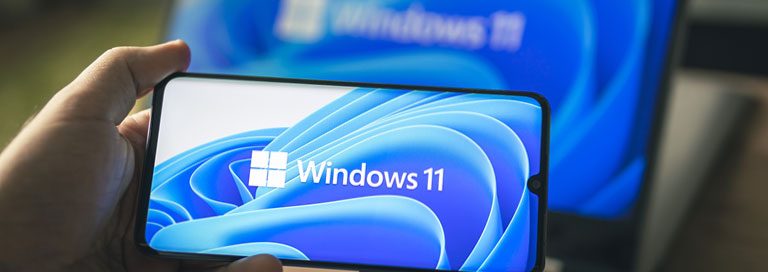Despite low-key launch, operating system update could make a big splash with remote and hybrid workers.
Microsoft has never been particularly modest about launching new operating systems. The Windows 95 launch party, for example, was hosted by Jay Leno and featured circus tents, a full-size Ferris wheel, and Bill Gates and Steve Ballmer dancing to the Rolling Stones’ “Start Me Up.” The company reportedly spent $500 million each on marketing campaigns for Windows XP and Vista and three times that for Windows 8.
However, the company has taken a far more measured approach with Windows 11, which became available on Oct. 5 as a free upgrade to compatible Windows 10 devices through Windows Update. Although Microsoft CEO Satya Nadella calls it the most significant Windows update in a decade, most PC users know nothing about it.
According to a recent Savings.com survey, 62 percent of Windows users are completely unaware that a new version of the operating system was being launched. Forty-five percent aren’t sure they’ll install the new OS, even though it is free to download.
Slow but Sure
Microsoft’s restrained approach to the release of its first major operating system update in six years is by design. The company says a “phased and measured” rollout will allow it to focus on quality. Initially, the update will be for compatible PCs based on hardware eligibility, reliability metrics, age of device and other factors that impact the upgrade experience. Microsoft says some major features will not be available at first but will be added over time “to make sure we’re providing (users) with the best possible experience.”
Support for Android applications is one of the more anticipated features, but that won’t be available until early 2022. The company plans to continue testing the feature with Windows Insiders over the coming months before making it generally available.
Windows 11 will use an Android subsystem and Intel Bridge technology to run Android apps natively, allowing users to move seamlessly between their phones and their PCs. The look and feel of the apps will be very similar across both devices. Through a partnership with Amazon, Android apps in the Amazon Appstore catalog will be available for download through the Microsoft Store.
User-Friendly Features
While Android support and other incremental enhancements will be introduced later, Windows 11 introduces a number of features designed specifically to support a work-from-anywhere world. For example, a streamlined user interface with a new Start menu utilizes the power of the cloud and Microsoft 365 to display recent files, regardless of the device that was used to create them.
Additionally, remote workers can easily initiate a Microsoft Teams conference through a chat window integrated in the taskbar. Users can launch video, voice or text chats right from the desktop and connect with others regardless of what computer or phone or tablet they are using — iOS, Android, PC or Mac.
Remote and hybrid users can access a virtualized Windows 11 desktop from any location via the desktop virtualization capabilities built into the cloud-based Windows 365 service. Users can stream all their applications, tools, data and settings through any web browser and access them with any PC or mobile device. Because the desktop isn’t linked to any particular device, users can switch devices without losing any updates or changes to the cloud desktop.
Windows 11 also addresses the unique security challenges of remote and hybrid work. It is secure by design with built-in hardware-based isolation, device encryption, virtualization-based security (VBS), hypervisor-protected code integrity (HVCI) and secure boot features. Microsoft says the combination of these features has been shown to reduce malware by 60 percent on tested devices.
Hardware Requirements
Not all Windows 10 PCs will be able to handle the upgrade due to some substantial hardware requirements. Some analysts suggest that anything purchased before 2019 may need to be upgraded or replaced. According to Microsoft, a PC should meet the following requirements to ensure a proper Windows 11 installation.
- Processor. 64-bit architecture at 1GHz or faster.
- RAM. 4GB or more.
- Storage. 64GB or larger storage device.
- System firmware. Unified Extensible Firmware Interface (UEFI) and Secure Boot capable.
- Security. Trusted Platform Module (TPM) version 2.0.
- Graphics card. Compatible with DirectX 12 or later with WDDM 2.0 driver.
- Display. High-definition (720p) display that is greater than 9 inches diagonally with 8 bits per color channel.
- Connectivity. Windows 11 Home edition requires Internet connectivity and a Microsoft Account (MSA) to complete device setup on first use.
Although Microsoft has taken a comparatively low-key approach to the Windows 11 launch, the phased approach should provide the opportunity to identify and address any glitches before widespread adoption. That should help ensure the latest edition of the world’s most popular operating system meets the needs of a changing workforce.




